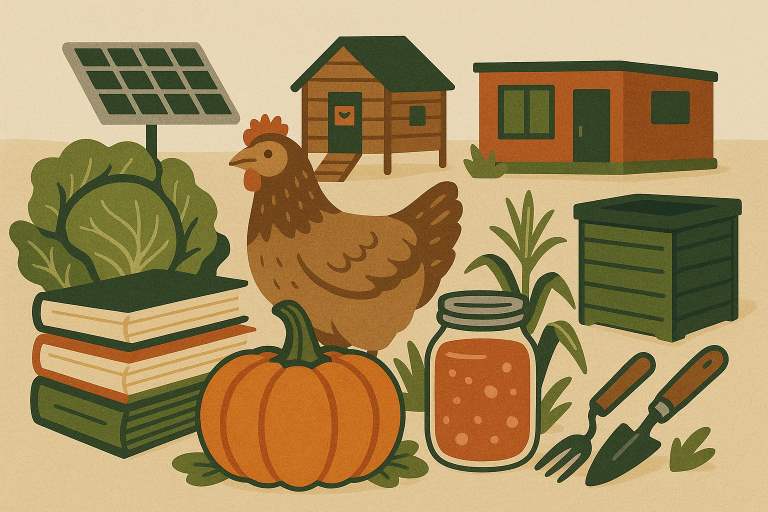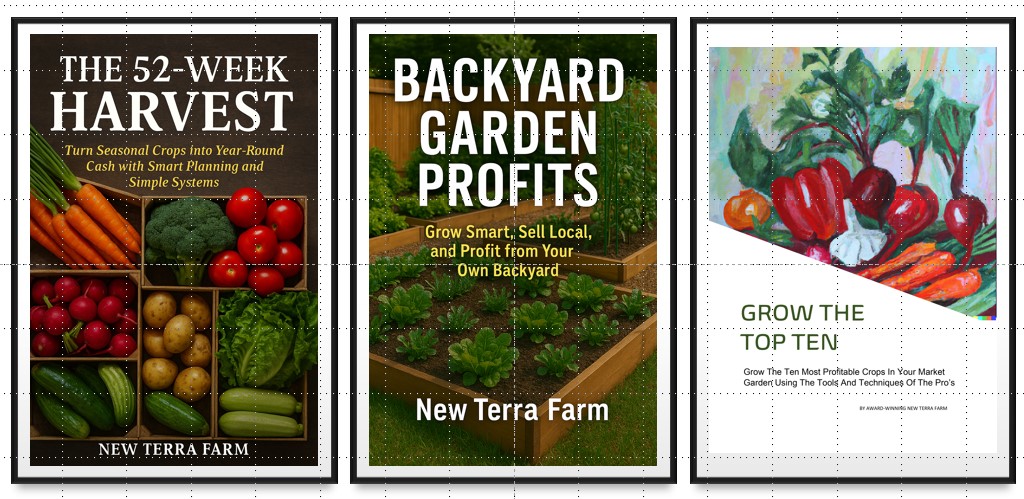The One
Acre Garden Plan: A Guide to Starting a Profitable Small Market Garden
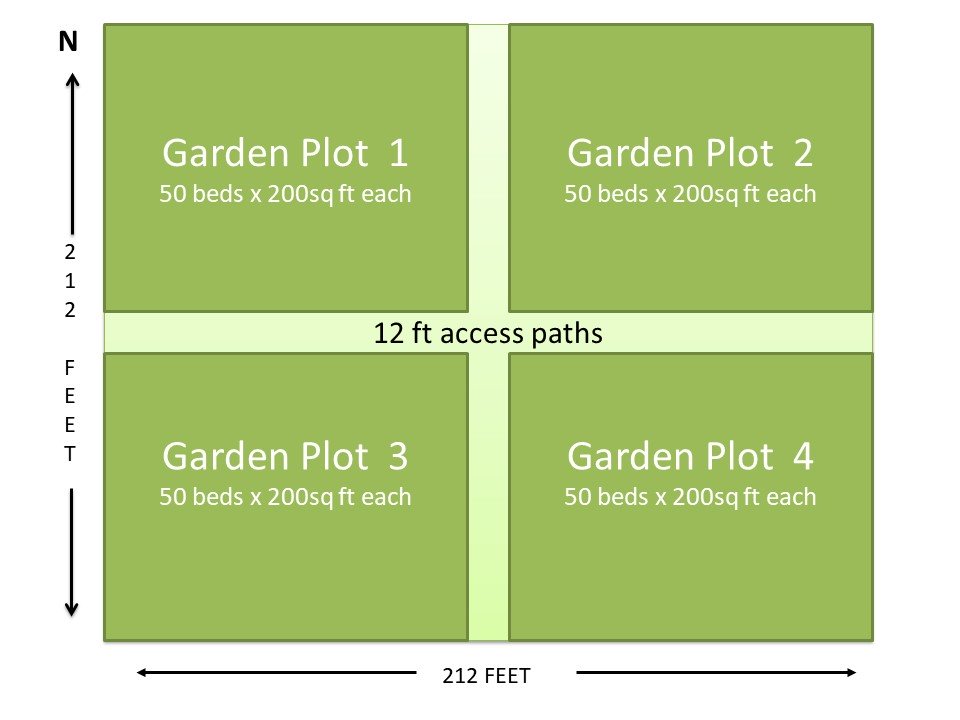 A prototype one acre garden plan for the small market grower A prototype one acre garden plan for the small market growerI get around 800 people a day coming to my New Terra Farm website. I’ve noticed a surge in interest among small property owners in starting their own market gardens. If that's you, read on. With the increasing demand for locally-grown, pesticide-free produce, a one acre garden can be a lucrative venture. My market garden providing food to 93 families was just about an acre in size. If you are a small organic grower looking to start your own market garden, my one acre garden plan will give you a good start on building a profitable garden of your own. And if you decide to take the next step after reading this page, you may want to check out Backyard Garden Profits, a book I wrote just for the small property owner who wants to start a successful, profitable and sustainable market garden in a small space. First Things First – MarketingCarefully Curated Resources For The Homesteader and Prudent Property Owner The world seems to be a little unsettled these days. I'm always looking for ways to make New Terra Farm more self-sufficient and productive. Here's a few of the best ways I've found to make self-sufficiency happen. Useful Homesteader Resources Here’s a rule that will keep you out of trouble on your small farm: don’t grow ANYTHING until you know who’s going to eat it (whether you and the family, or your customers). Find your market first; I’m a big fan of Community Supported Agriculture for this reason. All my farm goodies were sold before they were even grown. As a bonus, my CSA customers told me what they wanted me to grow before the season started! This is a huge advantage when building your one ace garden plan. But even without a CSA, make sure you have access to at least one (and preferably several) outlets for your farm goodies. A near-by farmers market, or local restaurants or institution or schools can be good choices. When I sold to restaurants and schools, I met with the chefs before my season started. I asked what they needed that I could provide, and basically grew to order for them. This also helped inform my garden plan. I also launched and ran the Merrickville Mid-Week Market for a number of years. We had a couple dozen vendors on-site every Wednesday. An important point, contact the market manager early to confirm you can get a booth. Make sure they can support another produce grower. I limited the number of vendors in any given category, although I put a priority on fresh produce. Make sure you are ‘in’ before the season gets underway. Choosing the Right Location for GrowingThe ideal plot of land for your one acre garden receives full sunlight throughout the day and has good soil drainage. The area also needs access to a water source. Additionally, ensure that the land is zoned for agricultural use and check if there are any restrictions or permits required. This is usually not a problem with market gardens, but never underestimate the power of the bureaucracy to shut down gainful enterprise; check with your local by-law guy. What about
a ‘less than ideal’ plot of land? My garden has mostly full sun, and
pretty good drainage expect for one spot to the south-east side that stays wetter
than the rest later in the year. You need to adapt your garden plan to the site conditions. I use the semi-shady parts of my garden to grow crops that don’t require full sun to produce. It’s also a good spot for crops that appreciate a little shade in the heat of full summer. The last-to-drain spot I just plant later in the season. My earliest crops go into the areas that are high and dry. Soil
Preparation and Fertility
We are blessed with deep clay-loam, very fertile topsoil in our garden area. We knew the area had been in pasture for many years, and grew a bountiful crop of wild plants. In the spring it looked like a wildflower garden! But if you have any doubts about your soil fertility, best to conduct a soil test to determine nutrient levels and pH. Based on the results, amend the soil with organic matter, such as compost or well-rotted manure, to improve fertility and structure. We use an annual application of 3-year-old composted horse bedding to keep our garden producing. Seek out all the animal manure you can find. Spend some money, it will be worth it. Compost it well before application. It's hard to apply too much compost. See also my section below about rotating small livestock through the garden area. We hired a neighbour farmer to plow and disc the big garden. For the first couple years I used a walk-behind rototiller to make the raised beds. Then I found a neighbour with tractor-driven bed shaping equipment and he did the whole garden for me in one afternoon. One Acre
Garden Plan Layout
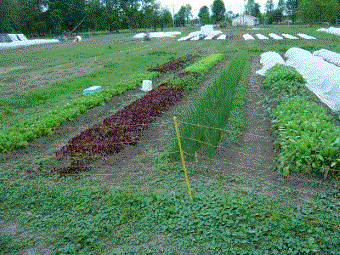 My one acre garden looking south. Note trees overlooking south-east corner, the shady spot. My one acre garden looking south. Note trees overlooking south-east corner, the shady spot.Take a look at that top graphic, that's just about how my main garden was laid out. That garden consisted of 200 raised beds, each 50 feet long and 30 inches wide, with an 18 inch path between them. Total bed area equals 50 feet x 48” x 200 = 40,000 square feet. My beds were oriented north-south for maximum sun exposure. The garden was divided into four plots, with 50 beds in each plot. The south-east plot had that shady and last- to-drain area, so I planned accordingly. The 4 plots were separated by 12-foot wide access paths running north-south and east-west. Having multiple plots lets you plan for crop rotation to maintain soil fertility and reduce pests. It also makes it easier for me to group plants by irrigation method e.g. I planted my earliest root crops and salad crops in the same plot to water with the micro sprinklers. I rotated the first-planted area each year among the three plots that were available early in the season. Our crop rotation was pretty simple,
Plot 4, the shadier wet one, we played by ear; it was for later plantings of short-season crops. As a bonus, I could also rotate my piggies and chickens through the earliest-planted and harvested areas. I used portable housing and electric net fencing to keep them out of the other garden areas. We could easily toss garden waste over the fence as a treat for the livestock. The best way to compost garden waste is to run it through a pig! Crop
Selection For Your One Acre Garden
We started with a list of about 20 cultivars, and (because we launched a CSA) we could refine that by talking to our customers before the season started. We also contracted with a local organic grower to provide us potatoes throughout the season. She was set up with potato planting, cultivation and harvesting equipment on her tractor, so this worked out pretty well. I've included potatoes and sweet potatoes in the selection below so you have the option of growing your own. 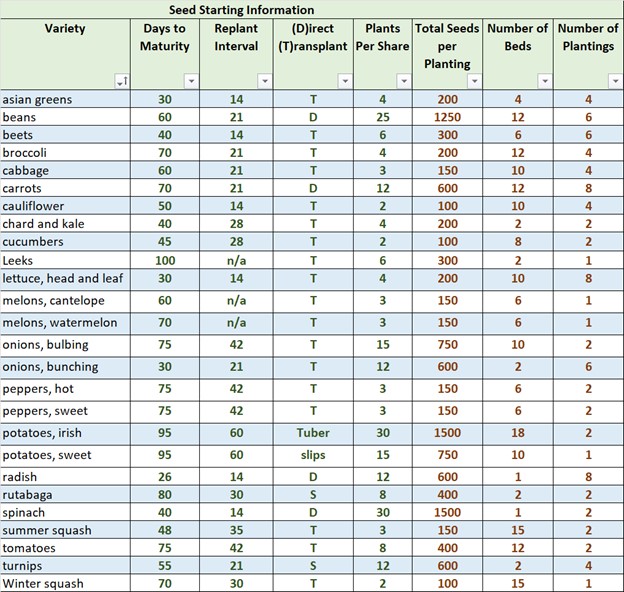 One acre garden plant list for 200 beds One acre garden plant list for 200 bedsOf course you have to adapt this list to your growing conditions and your market. The list I compiled in 'Grow The Top Ten Most Profitable Vegetables' is a good place to start. Protecting Your GardenPrevention is always easier and cheaper than intervention when it comes to managing and protecting your crops.
You may recall in Small Farm Success Factors I went into some detail about the kinds of information you need to keep. We closely monitor our crop production using our planning spreadsheet as a guide. We know exactly how much of each vegetable we need to serve our customers. If a particular crop is not germinating well, or some transplants do not perform, we can usually take corrective action in time to save the season. Now Go Thou Forth and Build Your Own One Acre Garden Plan
There is more to managing a market garden than just this of course, including crop care and harvest and storage. But this is the starting point for planning. Starting a one acre garden can be a profitable venture for small organic growers. With careful planning, proper soil preparation, strategic crop selection, and effective crop management, you can maximize your yield and profits. Get a Head Start With The 'Small Grower Book Bundle'If you want a head-start on the next season, this book bundle will provide you with valuable information to launch, market and manage a profitable small market garden. In the Small Grower Bundle you get the three books shown plus custom designed worksheets and software to help you plan and manage your garden. You can see more here or 'add to cart' to get started right away. After payment you will receive a download link to get this valuable bundle right away. No waiting for a physical book to be shipped.
|
